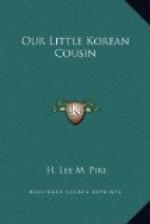As Yung Pak and his companions passed along the dirty streets of Seoul toward a gate in the great wall, a curious crowd was attracted by the unusual sight. This mob of men and boys were good-natured, but very curious, and it gathered so close as to impede the progress of the ponies. Moreover, a watchful eye had to be kept on all the luggage, lest some over-covetous person might steal the provisions and supplies on the ponies’ backs.
Notwithstanding the slow progress made by Ki Pak’s company, it took only a short time to pass through the narrow streets and out by the great gate, leaving behind the noisy mob of men and boys who had followed them to the city’s wall.
Once outside, upon the road which wound around and over the high hills that surround the city, the pure country air seemed very sweet and refreshing to Yung Pak, who knew nothing of life outside Seoul. This was his first journey into the country, and the many strange sights drew exclamations of surprise and wonder from him. The green waving grass and swaying foliage of the trees were ever new sources of joy and pleasure, and the delicate odours which the breezes bore to his sensitive nostrils were refreshing and life-giving.
Among the strange sights which attracted Yung Pak’s attention, as they rode along through the country, were some very curious figures erected by the roadside. These were posts, one side of which was roughly planed. On the upper part of each of these posts was a rude carving of a hideous human face with prominent teeth. The cheeks and teeth were slightly coloured. A most fiendish appearance was presented by these figures, called by the Koreans syou-sal-mak-i, and if looks counted for anything, they ought well to serve their purpose,—the scaring away of evil spirits from the village near which the figures always stood. The mile-posts, or fjang-seung, along the way were often similarly decorated.
[Illustration: “On the upper part of each of these posts was A rude carving”]
Another curiosity by the wayside which led to wonder on Yung Pak’s part was an old trunk of a tall tree. For about thirty feet from the ground this was painted in coloured stripes very much like a barber’s pole. The top and branches of the tree had been trimmed off, and the upper end was rudely carved in a shape representing a dragon with a forked tail. From the head, which resembled that of an alligator, hung various cords, to which were attached small brass bells and a wooden fish. Wang Ken told Yung Pak that this was a monument to some famous Korean “doctor of literature.”
On the first day’s journey toward Chang-an-sa the party made good progress. The plan was to get to Yong-pyoeng, about twenty miles from Seoul, before nightfall. To you this would seem a short day’s journey, but when it is remembered that many of the servants were on foot, and that the little ponies were heavily loaded, it does not seem so strange that more ground could not be covered in one day. In addition, in many places the roads were poor, though in the valleys there was a smooth bottom where the sand had washed down from the hills.




